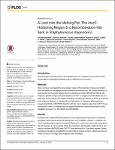A Look into the Melting Pot: The mecC-Harboring Region Is a Recombination Hot Spot in Staphylococcus stepanovicii
Semmler, Torsten
Harrison, Ewan M.
Lübke-Becker, Antina
Ulrich, Rainer G.
Wieler, Lothar H.
Guenther, Sebastian
Stamm, Ivonne
Hanssen, Anne-Merethe
Holmes, Mark A.
Vincze, Szilvia
Walther, Birgit
Introduction: Horizontal gene transfer (HGT) is an important driver for resistance- and virulence factor accumulation in pathogenic bacteria such as Staphylococcus aureus. Methods: Here, we have investigated the downstream region of the bacterial chromosomal attachment site (attB) for the staphylococcal cassette chromosome mec (SCCmec) element of a commensal mecC-positive Staphylococcus stepanovicii strain (IMT28705; ODD4) with respect to genetic composition and indications of HGT. S. stepanovicii IMT28705 was isolated from a fecal sample of a trapped wild bank vole (Myodes glareolus) during a screening study (National Network on “Rodent-Borne Pathogens”) in Germany. Whole genome sequencing (WGS) of IMT28705 together with the mecC-negative type strain CM7717 was conducted in order to comparatively investigate the genomic region downstream of attB (GenBank accession no. KR732654 and KR732653). Results: The bank vole isolate (IMT28705) harbors a mecC gene which shares 99.2% nucleotide (and 98.5% amino acid) sequence identity with mecC of MRSA_LGA251. In addition, the mecC-encoding region harbors the typical blaZ-mecC-mecR1-mecI structure, corresponding with the class E mec complex. While the sequences downstream of attB in both S. stepanovicii isolates (IMT28705 and CM7717) are partitioned by 15 bp direct repeats, further comparison revealed a remarkable low concordance of gene content, indicating a chromosomal “hot spot” for foreign DNA integration and exchange. Conclusion: Our data highlight the necessity for further research on transmission routes of resistance encoding factors from the environmental and wildlife resistome.
Dateien zu dieser Publikation
Keine Lizenzangabe

